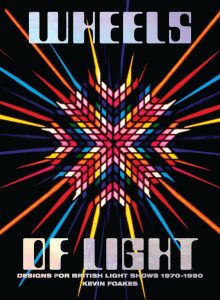The book exists because of (and treats as its central hub) Optikinetics – the UK manufacturer formed by Neil Rice and Phil Brunker in 1970 and, under the ownership of Rob Stitcher, is still going strong to this day.
‘Opti’ (as it has always been known) was not the first – or by any means the only – creator and purveyor of the projection effects which characterised the era. But they were a central player: they designed and built the iconic Solar 250 projector, and they are the only company influencing that powerfully creative time to have survived through to the present day.
The author’s research – triggered by a modern-day DJ’s encounter with a Solar 250 projector and Luton-based Optikinetics – has resulted in a book which is nothing less than a jewel of entertainment lighting history.
Always engaging, and with an obviously warm regard for his subject, Foakes takes the reader back to the early days of effect lighting – to bubbling oils, to Aldis projectors and the extraordinary, hand-painted effect wheels that would today grace the walls of any art collection.
Although it predominantly focuses on the artworks themselves, the book also provides a fascinating overview of those who drove this cultural phenomenon. Those early days of effects projection, from the early 1960s and through the ‘70s and ‘80s, have been a source of fascination and inspiration for light artists and lighting designers ever since. From strobing, monochrome op-art at the Fillmore, to The Pink Floyd bathed in swirling, coloured liquid projections at the UFO Club, they were innovations that have cast many long and wonderful shadows – through disco, Punk, rave and beyond.

We encounter light artists such as Mark Boyle and Joan Hills, who provided light shows for The Soft Machine and Jimi Hendrix; Mike Leonard and Peter Wynne Willson for The Pink Floyd; Colin Fulcher (a.k.a. Barney Bubbles’) who would later work as a graphic designer for Elvis Costello and Ian Dury; Jack Bracelin and his Five Acre Lights; and, of course, Jonathan Smeeton (a.k.a. ‘Liquid Len’), lighting designer for Hawkwind.
We meet Krishna Lights, run by Jimmy Doody and Keith Canadine and based in London’s Goodge Street, and see their influence on Neil Rice, a young art student captivated by the opportunities unfolding around him. Rice recalls of Krishna Lights, “There I saw a liquid wheel for the first time, as well as the new Rank Aldis Tutor 2. This was about as revolutionary at the time as LED lighting is now.”
We see the silk-screen printed, hand-painted effect wheels, the sumptuous creations of artists and innovators such as David A. Hardy, Maggie Gould, Steve Maher and Roy Wilkinson. We are introduced to figures such as Micky Thompson of Pluto Electronics, Colin Cadle of Andromeda Spiral Lighting and Larry Wooden of Orion Lighting, the originator of the continuous rotating panorama effect.
More than anything, it’s an important record of a hugely influential period. It doesn’t claim to be comprehensive, or the final word on the matter, but for anyone with an interest in performance lighting, this is a book to have and to cherish.
Wheels of Light is part of the Four Corners Irregulars, a series of visual histories of modern British culture.


